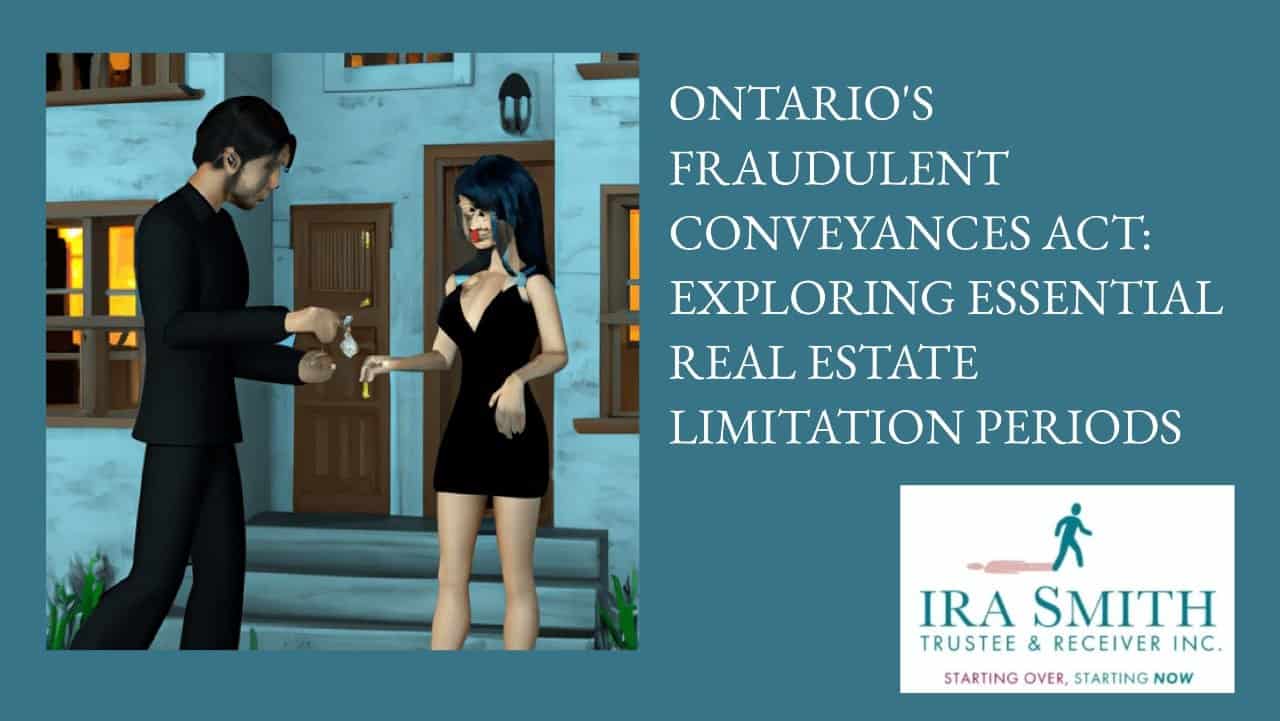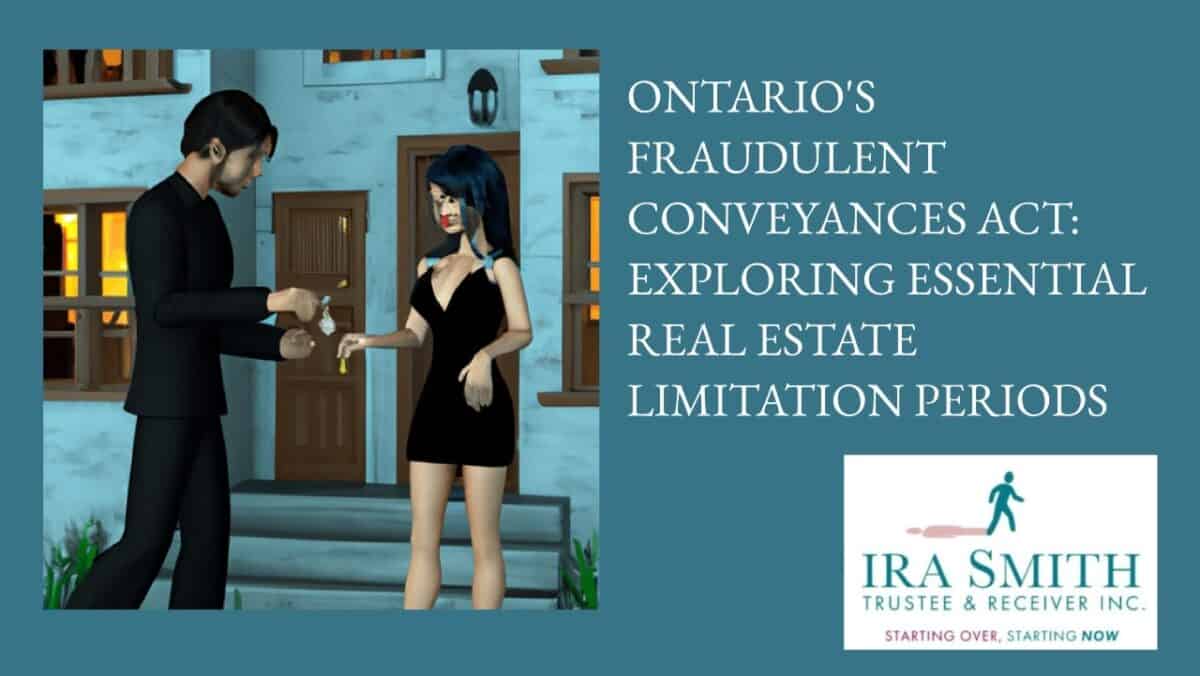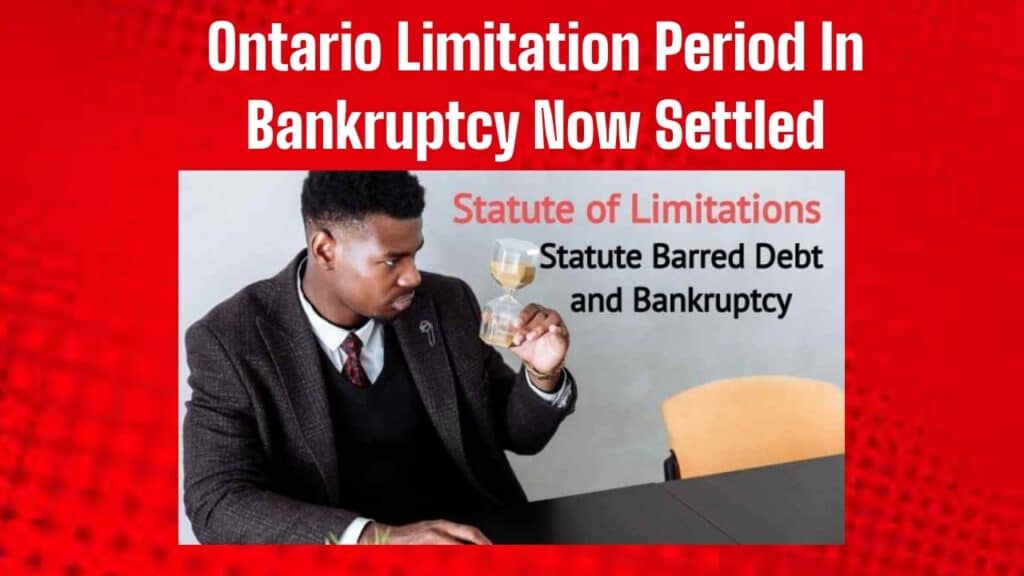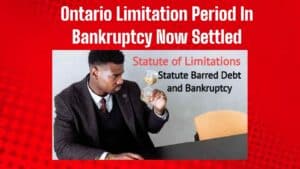Fraudulent Conveyances Act: Introduction
In this Brandon’s Blog, we discuss the Ontario Fraudulent Conveyances Act, R.S.O. 1990, c. F.29 and its elaborate implications within the substantial world of real property transactions. We will navigate the labyrinthine provisions of the Act, and enhance your understanding using a real-world example. We will also clarify the connection between the Fraudulent Conveyances Act, fraudulent conveyances and Ontario limitation periods in the realm of real estate transactions.
We will also check out the interaction between the Fraudulent Conveyances Act and limitation periods in realty transactions. Limitation periods play a considerable duty in determining when lawsuits can be brought forward, and comprehending just how they associate with fraudulent conveyances is important in navigating the intricacies of the property landscape. We will check out a recent decision of the Court of Appeal for Ontario released on August 4, 2023, which clears up this whole issue.
How the Fraudulent Conveyances Act works
The Ontario Fraudulent Conveyances Act is a stunning piece of Ontario provincial law that stands as a guardian of creditors’ legal rights versus the treacherous schemes of debtors. With unfaltering willpower, this Act has been made to ward off any and all efforts by debtors to slither out of their financial obligations by slyly moving their properties to others.
In its noble search for justice, the Fraudulent Conveyances Act makes sure that creditors are protected from the conniving strategies of debtors who look to avert their obligations. This legislation supplies a strong structure for creditors to attack any kind of potentially uncertain transactions and obtain the return of any type of funds or properties that may have been cunningly relocated.
Within the realm of Ontario’s legal landscape, the Fraudulent Conveyances Act tackles the extensive duty of guarding the position of creditors versus the shrewd maneuvers entailing the surreptitious change of ownership of property, either personal or real, by individuals or corporations trying to move their assets away from the responsibility of their debt obligations through webs of deceit.
Operating as a linchpin of justice, this Fraudulent Conveyances Act plays a crucial duty in the upkeep of equity and also moral integrity within the realm of property dealings. It possesses the power to nullify those transactions that arise from the indelible mark of deceit, thereby fortifying the bedrock concepts of fairness and equity.
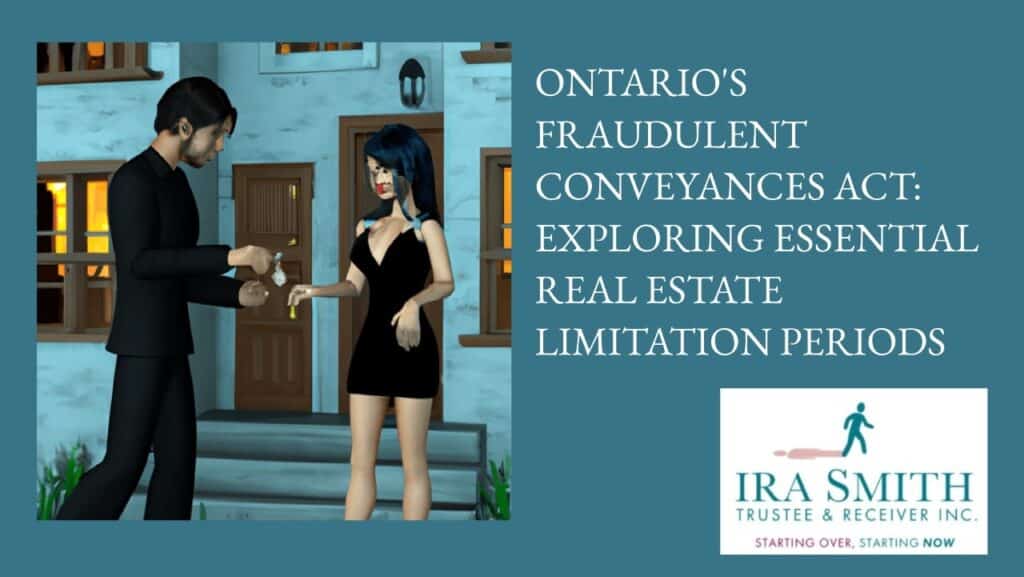
Definition of fraudulent conveyance
Within the province of Ontario, the concept of a fraudulent conveyance takes shape as the orchestration of a maneuver wherein one or more assets, akin to pawns on a strategic board, are relocated, driven by the very purpose of ensconcing these assets beyond the reach of creditors. This type of transfer garners the label of fraudulent, a designation reflecting a means to veil and shroud property, rendering it escaping the reach of creditors.
This legislative framework, known as the Ontario Fraudulent Conveyances Act, unveils a list of specific benchmarks, all for the recognition of a transfer swathed in the cloak of deception and thus null and void. A transfer imbued with an intent to stall and thwart creditors’ aspirations or, alternatively, the transfer is one with a price tag significantly below fair market valuation. Upon a court determining that a transfer is a fraudulent conveyance, the property is undone, returning back to the debtor owner’s estate for the benefit of its creditors.
Who is covered by the Fraudulent Conveyances Act and what actions are prohibited under the Act?
The Fraudulent Conveyances Act applies to the affairs of both individuals and corporate entities. This legislation stands as a guardian, shielding the vested interests of creditors. Its purpose is to undo the webs of illicit property transfers aimed at moving property out of the reach of creditors.
Any transaction found by the court to violate the Act will be reversed. The heart of this Act aims to maintain integrity in transactions and remedy those designed to be deceitful.

Importance of understanding limitation periods in business transactions
Understanding limitation periods within the world of transactions is very important in comprehending everybody’s rights. An astute grasp of limitation periods is extremely vital for any person pondering initiating a lawsuit. This is particularly true in the world of attempting to turn around deals as being in breach of the Fraudulent Conveyances Act.
As you will certainly see below, this is the essence of the recent decision of the Court of Appeal for Ontario entailing a real estate deal that a bank was attempting to obtain reversed as contravening the Fraudulent Conveyances Act.
Time Period for fraudulent conveyance actions: Limitations Act vs Real Property Limitations Act
The problem needing a decision from the Court of Appeal for Ontario when it comes to Bank of Montreal v. Iskenderov, 2023 ONCA 528 (CanLII) discussed below, is, when it comes to a potentially fraudulent conveyance involving real estate, what is the limitation period?
Under the Limitations Act, 2002, S.O. 2002, c. 24, Sched. B, the restriction duration, or time period to bring a fraudulent conveyance action in Ontario is 2 years from the date of the transfer or disposition of property. However, the Real Property Limitations Act, R.S.O. 1990, c. L.15 (RPLA) states:
“4. No person shall make an entry or distress, or bring an action to recover any land or rent, but within ten years next after the time at which the right to make such entry or distress, or to bring such action, first accrued to some person through whom the person making or bringing it claims, or if the right did not accrue to any person through whom that person claims, then within ten years next after the time at which the right to make such entry or distress, or to bring such action, first accrued to the person making or bringing it.”
When it comes to real estate, if a creditor wishes to challenge a fraudulent transfer under the Fraudulent Conveyances Act, do they have a two-year window from the date of the transfer to initiate legal proceedings or a ten-year window? That is the question the Court of Appeal for Ontario answered in Bank of Montreal v. Iskenderov.

A real-world example of a legal proceeding related to fraudulent conveyance actions: Bank of Montreal v. Iskenderov, 2023 ONCA 528 (CanLII)
The Bank of Montreal was embroiled in a legal conflict before the Court of Appeal for Ontario. The plaintiff, or respondent, is the Bank of Montreal, while the defendants, or applicants in the appeal, are Roufat Iskenderov and Elena Lazareva. At issue is the transfer of property from Mr. Iskenderov to his spouse, which the bank claimed was a fraudulent conveyance.
Initially, the motion court found in favour of the Bank of Montreal, specifying the ten-year duration applies in their litigation under the Fraudulent Conveyances Act and allowing the case to proceed. Nonetheless, the applicants appealed, suggesting that a two-year period should apply.
To totally resolve the legal concern bordering which statute and limitation period applies to an action to reserve a fraudulent conveyance of real property, the appeal court assembled a five-judge panel.
In 2008, Mr. Iskenderov transferred his share of a jointly owned home to Ms. Lazareva as part of a separation agreement. In 2008, Mr. Iskenderov fraudulently defaulted on a $400,000 line of credit with the Bank of Montreal. After legal proceedings, Mr. Iskenderov filed for bankruptcy in 2009 and was discharged in 2012.
The Bank began its legal action to challenge the home transfer as fraudulent in 2013. The motion judge considered several issues, including the applicable limitation period and the discharge of a pending litigation certificate.
Legal proceedings related to fraudulent conveyance actions: The key points in this case
Here are the key points of this case:
- The case involves a dispute related to a transfer of real property deemed fraudulent. The issue arises about whether the appellant should be bound by a previous court decision (*Anisman v. RPLA*) regarding the applicable limitation period.
- The motion judge determined that the ten-year limitation period applies, and the action was filed within that time. There was no violation of the limitation period.
- The motion judge considered the discoverability of the claim, referencing *Grant Thornton LLP v. New Brunswick*, stating that if the two-year limitation period applied, there was a potential issue regarding when the appellant had knowledge of liability. Summary judgment might not have been granted in this case.
- The motion judge decided not to discharge the certificate of pending litigation for the delay due to several reasons: a lack of evidence that the appellant had thwarted intentions to deal with the property, most of the delay caused by the appellants, the risk of prejudice to the Bank due to previous fraudulent transfer, absence of security offered to the Bank, and the Bank’s readiness for trial.
- The appellants raised three issues on appeal, including whether the motion judge’s reliance on *Anisman (ONCA)* for the ten-year limitation period was a legal error. They also questioned the dismissal of the action for delay, but the motion judge ruled in favour of the Bank, extending the time for trial.

fraudulent conveyances act
The original legal proceeding related to the fraudulent conveyance action
In a separation agreement dated January 10, 2008, Mr. Iskenderov transferred his interest in their jointly held matrimonial home to Ms. Lazareva. On April 28, 2008, Mr. Iskenderov defaulted on a $400,000 line of credit to the Bank of Montreal, which he had obtained fraudulently.
After the Bank obtained a judgment against Mr. Iskenderov for $483,449.89 on January 14, 2009, he made an assignment into bankruptcy on March 24, 2009. He received his bankruptcy discharge in November 2012. The stay of proceedings arising from the bankruptcy was lifted by the court to enable the Bank of Montreal to proceed to pursue its judgment against him under s. 178 of the Bankruptcy and Insolvency Act, R.S.C. 1985, c. B-3 (“BIA”), being a claim not discharged by his discharge from bankruptcy.
The Bank started its litigation to declare the transfer of the home a fraudulent conveyance and to set it aside under the Fraudulent Conveyances Act on June 18, 2013. On February 17, 2015, under s. 38 of the BIA, the Bank acquired from the Trustee the right to commence this action and on March 4, 2015, the Bank obtained an Assignment of Claim from the Trustee. The Bank also successfully obtained a certificate of pending litigation against the property in March 2015. The litigation “moved sluggishly along”, with delay by both parties.
The motion court needed to deal with numerous crucial concerns in the case, including whether a previous decision made by the Court of Appeal for Ontario would bind the current case. In that case (Anisman, Re) the appellate court had formerly ruled that the ten-year period under s. 4 of the RPLA related to an activity to declare a fraudulent conveyance of real property against creditors.
Additionally, the judge had to figure out whether the two-year limitation period under the Limitations Act should be used in the Fraudulent Conveyances Act action as well as if there was an authentic issue for trial regarding when the Bank first had knowledge of the transfer. There was additionally the matter of whether the certificate of pending litigation ought to be discharged because of delay and whether the entire case itself needs to be rejected for the very same reason.
The motion court was not tasked with establishing whether the contested transfer was a fraudulent conveyance; that issue was scheduled for trial if the matter was not discharged either as statute-barred or for delay.
The motion judge found that:
- The ten-year limitation period in the RPLA applies and the action was commenced well within that time.
- If the two-year limitation period had applied, there was a triable issue regarding when the Bank had the knowledge to give it the “plausible inference” of liability. Therefore summary judgment would not have been granted but the issue would have gone for trial.
- He would exercise his discretion not to lift the certificate of pending litigation.
- The appellants were more responsible than the Bank for the litigation delay. The matter was ready to be set down for trial, and there is potential merit to the action. For those reasons, the motion judge declined to dismiss the action for delay and granted the Bank’s motion to extend the time to set the action down for trial.
Considerations when evaluating liability and the applicable limitation period: The Court of Appeal for Ontario analysis
During the appeal, the appellants presented three points of contention. Firstly, they challenged the motion judge’s decision to follow the Anisman (ONCA) principle, which upholds the RPLA ten-year limitation period over the Limitations Act’s two-year limitation period in an action to declare a fraudulent conveyance of real property void against creditors. Secondly, they contested the motion judge’s finding of a triable issue regarding when the Bank actually discovered that it may have a claim if the shorter Limitations Act time period applies to its action under the Fraudulent Conveyances Act. Lastly, they raised concerns about the motion judge’s factual findings regarding the delays in the action, which they believed amounted to palpable and overriding errors.
The Court of Appeal for Ontario first looked at the origin of the present RPLA can be traced back to the Real Property Limitation Act, 1833, 3 & 4 Will. 4, c. 27 (U.K.), which has been in existence virtually unchanged since 1833. It was incorporated into the Ontario statutes in 1834 through an Act to amend the Law respecting Real Property, 1834, (U.C.) 4 Will. IV, c.
The wording of the limitation period for actions to “recover any land” in England and Ontario has remained the same over the years, although the duration of the limitation period has varied. In 1910, the provisions were moved from the Real Property Limitation Act, 1833, to form Part I of the Limitations Act, S.O. 1910, c. 34, where they remained until 2004. Parts II and III of the old Act were revoked, and Part I was renamed as the RPLA.
The appeal court held that before the enactment of the new Act, s. 4 of the RPLA or its equivalent provisions were never applied to an action for a fraudulent conveyance of land.
After reviewing appropriate case law, the five appellate judges unanimously agreed on all points of law, including:
- The Fraudulent Conveyance Act doesn’t revert property to the grantor; it removes obstacles to the creditor’s recovery and allows additional remedies.
- Successful creditors in a fraudulent conveyance action don’t necessarily need property return; a court declaration of conveyance as “void against” them suffices
- An Order under the Fraudulent Conveyances Act doesn’t change property title, but creditors can treat the transferee’s property as liable for debts.
- Fraudulent conveyance actions do not result in the recovery of land rights; the conveyance is voided.
- The Fraudulent Conveyances Act statute aims to enable creditors to execute against the land for debts owed by the transferor.
- The interpretation of “an action to recover any land” in the RPLA differs from its application in fraudulent conveyance cases.
- “To recover any land” doesn’t mean to regain lost property, but to obtain land by court judgment.
Therefore, the conclusion is that the Limitations Act, 2002 and not the RPLA applies to fraudulent conveyance actions. Therefore, the Court of Appeal for Ontario allowed the appeal by Roufat Iskenderov and Elena Lazareva and made the following orders:
- The applicable limitation period for the fraudulent conveyance action under the Fraudulent Conveyances Act is two years from the date of discovery of the claim by the respondent under s. 4 of the Limitations Act, 2002.
- The discoverability issue shall be tried together with the fraudulent conveyance issue and set down for trial in accordance with the order of the motion judge.
- Costs of the appeal to the appellants in the agreed amount of $7,500.00 inclusive of disbursements and HST.
So there is now going to be a trial of the issue of whether the Bank of Montreal was on time or not in bringing its action under the Fraudulent Conveyances Act, now that it has been settled that the limitation period for bringing the action under the Fraudulent Conveyances Act is a two-year time limit.
Fraudulent Conveyances Act: Conclusion
I hope you enjoyed this Fraudulent Conveyances Act Brandon’s Blog. It is important for everyone to understand what constitutes a fraudulent conveyance of property, either personal property or real estate, especially when the person or company transferring the property is insolvent. Problems with making ends meet are a growing concern in Canada, affecting individuals of all ages and income levels.
Creating a solid financial plan can be the key to unlocking a brighter and more prosperous future. By taking control of your finances, you can prioritize your expenses, set clear financial goals, and build a strong foundation for your dreams to come true. With the right mindset and approach, financial planning can empower you to regain control, eliminate this issue as a source of stress in your life and find peace of mind.
Individuals must take proactive measures to address financial difficulties and promptly seek assistance when necessary. It is crucial to recognize that financial stress is a prevalent concern and seeking help is a demonstration of fortitude, rather than vulnerability. Should you encounter challenges in managing your finances and find yourself burdened by stress, do not delay in pursuing aid.
Revenue and cash flow shortages are critical issues facing people, entrepreneurs and their companies and businesses with debt problems that are in financial distress. Are you now worried about just how you or your business are going to survive? Are you worried about what your fiduciary obligations are and not sure if the decisions you are about to make are the correct ones to avoid personal liability? Those concerns are obviously on your mind.
The Ira Smith Team understands these financial health concerns. More significantly, we know the requirements of the business owner or the individual that has way too much financial debt. You are trying to manage these difficult financial problems and you are understandably anxious.
It is not your fault you can’t fix this problem on your own and it does not mean that you are a bad person. The pandemic has thrown everyone a curveball. We have not been trained to deal with this. You have only been taught the old ways. The old ways do not work anymore. The Ira Smith Team uses innovative and cutting-edge methodologies, to adeptly navigate you through the intricacies of your financial challenges, ensuring a resolution to your debt-related predicaments without resorting to the rigours of the bankruptcy process. We can get you debt relief now!
We have helped many entrepreneurs and their insolvent companies who thought that consulting with a Trustee and receiver meant their company would go bankrupt. On the contrary. We helped turn their companies around through financial restructuring.
We look at your whole circumstance and design a strategy that is as distinct as you are. We take the load off of your shoulders as part of the debt settlement strategy we will draft just for you.
The Ira Smith Trustee & Receiver Inc. team understands that people facing money problems require a lifeline. That is why we can establish a restructuring procedure for you and end the discomfort you feel.
Call us now for a no-cost consultation. We will listen to the unique issues facing you and provide you with practical and actionable ideas you can implement right away to end the pain points in your life, Starting Over, Starting Now.
